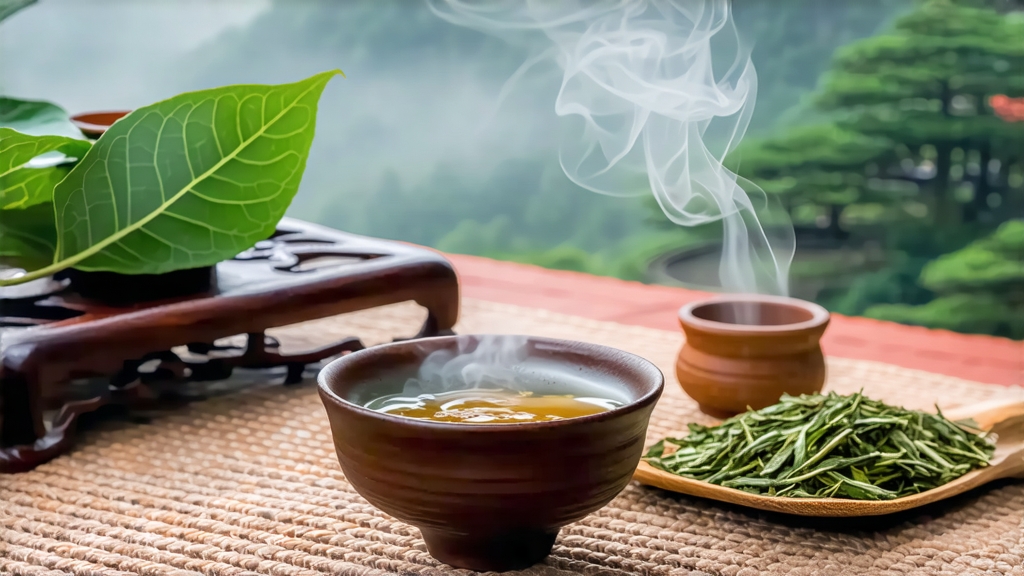
Tie Guan Yin, literally “Iron Goddess of Mercy,” is the most celebrated among China’s oolong teas, a fragrant bridge between green freshness and black depth. Born in Anxi, Fujian, its story blends myth, monkish devotion, and centuries of craft refinement. According to local legend, a humble farmer named Wei Yin tended an abandoned iron statue of Guan Yin, the Bodhisattva of Compassion. One night the goddess appeared in a dream, guiding him to a hidden shrub whose leaves, once plucked and infused, released an aroma so captivating that neighbors believed heaven itself had left a calling card. Wei Yin shared cuttings; the cultivar spread across Anxi’s granite ridges, and by the Qing dynasty the tea had become tribute, traveling north to the Forbidden City wrapped in silk and bamboo.
Anxi County sits on the Tropic of Cancer, where morning fog rolls off the Jinsha River and settles into valleys of iron-rich laterite soil. The elevation, 500–800 m, slows leaf growth, concentrating amino acids and floral volatiles. Five distinct sub-varietals have emerged from this micro-terroir: “Red Heart” Tie Guan Yin, the original heirloom prized for orchid notes; “Green Heart,” hardier and more yield-friendly; “White Heart,” pale-leafed and delicate; “Yellow Heart,” bred for warmer lowlands; and “Soft Stem,” whose flexible petioles suit modern shaking machines. Each retains the cultivar’s genetic signature—an oval leaf tip that droops like a praying hand—yet expresses different aromatics when exposed to Anxi’s diurnal temperature swing of 10 °C.
Plucking begins at dawn on the 20th–30th day after Qingming, when three half-open leaves atop a tender bud reach the “small to medium open” stage. Pickers wear bamboo baskets lined with banana leaf to prevent bruising; any crushed edge would oxidize unevenly, marring the jade-green center. Once back at the village workshop, the leaves are spread on reed trays and wilted under natural breeze and 26 °C shade—an initial withering that reduces grassy notes. Next comes the signature “shaking” or yaoqing: 6–8 short tosses in a bamboo drum rotating at 18 rpm. Each toss lasts 30 seconds, just long enough for leaf edges to bump against one another, rupturing cells and triggering oxidation enzymes. Masters listen for a rustle like light rain on silk; when the sound sharpens, they pause, letting residual heat migrate inward. This cycle repeats 4–5 times across the night, a choreography that shapes Tie Guan Yin’s hallmark “green center with red fringe.”
Oxidation is halted at 25–30 % by a 280 °C tumble in a gas-fired drum for 90 seconds—longer than green tea, shorter than black—locking in a pistachio-colored leaf. Immediately afterward the leaves are wrapped in square cloth bundles and entered into the “rolling-balling” machine, a pair of convex plates that gyrate 35 times per minute. Over 60 minutes the leaf mass is compressed, released, rewrapped, and compressed again, gradually curling into the tight pellet that resembles a dragonfly’s eye. These pellets are dried at 80 °C for three hours, reducing moisture to 4 %, then rested for 24 hours so internal aromatics stabilize. Finally comes the charcoal finishing: low embers of lychee wood impart a whisper of smoke that rounds the edges, evoking toasted almond without masking the orchid soul. A traditional batch requires 36 hours from leaf to finished tea, yet the best makers stretch it to 48, arguing that time itself is an ingredient.
To brew Tie Guan Yin gongfu style, begin with a 120 ml gaiwan, porcelain to accentuate high notes. Pre-heat with 95 °C water, then fill one-third capacity with 7 g of pellets—about two heaping teaspoons. The first infusion, 15 seconds, is a “wake-up rinse” discarded to open the leaf. Subsequent steeps progress: 25, 35, 45, 55, 70, 90 seconds, pushing the leaves to unfurl like miniature handscrolls. Use water filtered through bamboo charcoal; its slight sweetness amplifies the tea’s natural rock sugar finish. Pour in a high, thin stream to aerate, then decant fully to prevent bitterness